Web Monitor: Difference between revisions
No edit summary |
No edit summary |
||
| (5 intermediate revisions by 3 users not shown) | |||
| Line 1: | Line 1: | ||
[[Category:Applications]] | [[Category:Applications]] | ||
<span style="display:none" class="helpSource web_monitor">Web_Monitor</span> | <span style="display:none" class="helpSource web_monitor">Web_Monitor</span> | ||
<span style="display:none" class="helpSource web_monitor_status">Web_Monitor#Status</span> | |||
<span style="display:none" class="helpSource web_monitor_categories">Web_Monitor#Categories</span> | <span style="display:none" class="helpSource web_monitor_categories">Web_Monitor#Categories</span> | ||
<span style="display:none" class="helpSource web_monitor_site_lookup">Web_Monitor#Site_Lookup</span> | |||
<span style="display:none" class="helpSource web_monitor_flag_sites">Web_Monitor#Flag_Sites</span> | <span style="display:none" class="helpSource web_monitor_flag_sites">Web_Monitor#Flag_Sites</span> | ||
<span style="display:none" class="helpSource web_monitor_pass_sites">Web_Monitor#Pass_Sites</span> | <span style="display:none" class="helpSource web_monitor_pass_sites">Web_Monitor#Pass_Sites</span> | ||
| Line 10: | Line 12: | ||
{| width='100%' | {| width='100%' | ||
|- | |- | ||
| align="center" | [[Image: | | align="center" | [[Image:WebMonitor.png|128px]] '''Web Monitor''' | ||
| align="center" | | | align="center" | | ||
{| | {| | ||
| Line 32: | Line 34: | ||
== About Web Monitor == | == About Web Monitor == | ||
Web Monitor monitors HTTP traffic on your network to | Web Monitor monitors HTTP and HTTPS traffic on your network to log web activities and flag inappropriate content. | ||
* '''Real-time classification and updates''': When your users visit a site, | * '''Real-time classification and updates''': When your users visit a site, NG Firewall sends the URL to the [https://www.webroot.com/us/en/business/threat-intelligence/internet/web-classification-and-reputation-services Webroot BrightCloud®] to be categorized. When the data is returned, NG Firewall keeps a temporary local cache of the site and category to speed up the process the next time the URL is requested. This data is then used to flag or allow users access to the site they have requested, all without any appreciable increase in load time. If a site is not categorized upon request, it is autocategorized by our partners at [https://www.webroot.com Webroot] and put into a queue to be verified by a human. Because this is done dynamically, new sites and updated URLs are allowed or flagged according to your settings without additional intervention, plus you have the option of requesting [https://www.brightcloud.com/tools/url-ip-lookup.php recategorization] of sites. | ||
* '''HTTPS Filtering''': Web Monitor has multiple techniques to deal with HTTPS, SSL-encrypted HTTP. HTTPS traffic is encrypted so only some information is visible and this information is used to categorize the session. More information on how this is down below. | * '''HTTPS Filtering''': Web Monitor has multiple techniques to deal with HTTPS, SSL-encrypted HTTP. HTTPS traffic is encrypted so only some information is visible and this information is used to categorize the session. More information on how this is down below. | ||
* '''Detailed categorization''': Web Monitor offers | * '''Detailed categorization''': Web Monitor offers 79 categories and tens of billions of URLs. The Web Monitor database is over 100 times larger and more accurate. The abundance of categories means that you can narrow your scope - maybe you want to flag websites related to nudity, but allow sites dealing with Sexual Education. | ||
=== Traffic Flow === | === Traffic Flow === | ||
| Line 109: | Line 111: | ||
The '''Rules''' tab allows you to specify rules to Flag traffic that passes through Web Monitor. | The '''Rules''' tab allows you to specify rules to Flag traffic that passes through Web Monitor. | ||
The [[Rules|Rules documentation]] describes how rules work and how they are configured. Web Monitor uses rules to determine when to flag specific | The [[Rules|Rules documentation]] describes how rules work and how they are configured. Web Monitor uses rules to determine when to flag specific sessions. Flagging a session marks it in the logs for reviewing in the event logs or reports, but has no direct effect on the network traffic. | ||
{{AppScreenshot|web-monitor|rules}} | {{AppScreenshot|web-monitor|rules}} | ||
Latest revision as of 18:37, 3 May 2022
 Web Monitor Web Monitor
|
|
About Web Monitor
Web Monitor monitors HTTP and HTTPS traffic on your network to log web activities and flag inappropriate content.
- Real-time classification and updates: When your users visit a site, NG Firewall sends the URL to the Webroot BrightCloud® to be categorized. When the data is returned, NG Firewall keeps a temporary local cache of the site and category to speed up the process the next time the URL is requested. This data is then used to flag or allow users access to the site they have requested, all without any appreciable increase in load time. If a site is not categorized upon request, it is autocategorized by our partners at Webroot and put into a queue to be verified by a human. Because this is done dynamically, new sites and updated URLs are allowed or flagged according to your settings without additional intervention, plus you have the option of requesting recategorization of sites.
- HTTPS Filtering: Web Monitor has multiple techniques to deal with HTTPS, SSL-encrypted HTTP. HTTPS traffic is encrypted so only some information is visible and this information is used to categorize the session. More information on how this is down below.
- Detailed categorization: Web Monitor offers 79 categories and tens of billions of URLs. The Web Monitor database is over 100 times larger and more accurate. The abundance of categories means that you can narrow your scope - maybe you want to flag websites related to nudity, but allow sites dealing with Sexual Education.
Traffic Flow
When scanning traffic, Web Monitor evaluates the pass lists, flag lists, categories, and rules at two distinct points of the HTTP transaction. The first evaluation happens after the request is received from the client and before it is forwarded to the server. The second is after the response is received from the server and before it is passed back to the client. This allows a high degree of monitoring over both resources that are requested, and content that is returned in response.
HTTP Request
When evaluating HTTP requests, Web Monitor applies the configured rules and lists in the following order:
- A lookup is performed to determine the category for the requested site. The category is attached to the session for use by Web Monitor as well as other applications.
- The source IP of the request is checked against the Pass Clients list. If a match is found, the traffic is allowed.
- The destination site of the request is checked against the Pass Sites list. If a match is found, the traffic is allowed.
- The destination site of the request is checked against the Flag Sites list. If a match is found, the traffic is flagged.
- The traffic details are passed to the Rules list. If a match is found, the traffic is allowed and possibly flagged based on the options configured in the rule that was matched.
- The category determined in step #1 is compared to the Categories list, and the traffic is allowed and possibly flagged based on the corresponding match. If the category could not be determined, the traffic is allowed.
HTTP Response
When evaluating HTTP responses, Web Monitor applies the configured rules and lists in the following order:
- The source IP of the request is checked against the Pass Clients list. If a match is found, the traffic is allowed.
- The site from which the response was received is checked against the Pass Sites list. If a match is found, the traffic is allowed.
- The traffic details are passed to the Rules list. If a match is found, the traffic is allowed and possibly flagged based on the options configured in the rule that was matched.
Settings
This section reviews the different settings and configuration options available for Web Monitor.
Status
This displays the current status and some statistics.
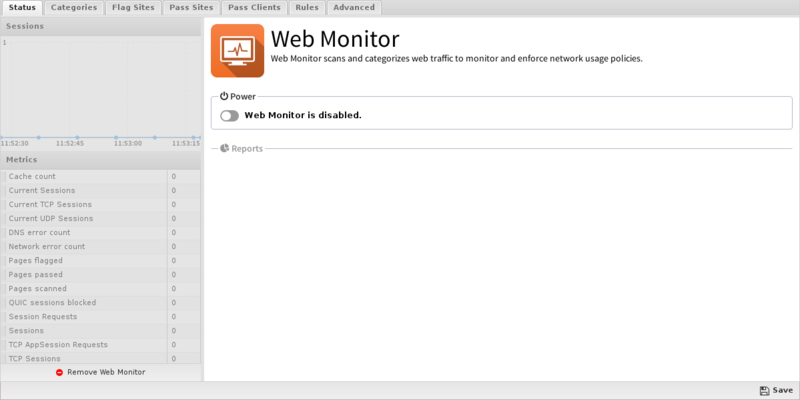
Categories
Categories allows you to customize which categories of sites will be flagged. Categories that are flagged will allow the user to access the site, but will be silently flagged as a violation for event logs and Reports. These flag actions operate the same way for all of the different Web Monitor options.
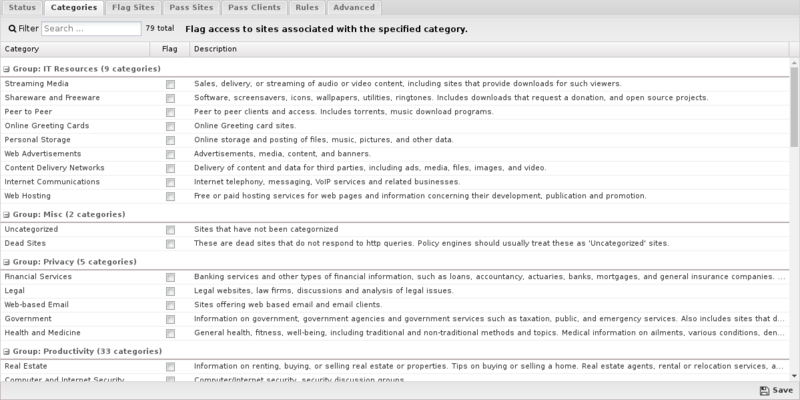
Flag Sites
Under Flag Sites you can add individual domain names you want to be flagged - just enter the domain name (e.g. youtube.com) and specify your chosen action. This list uses URL Matcher syntax.
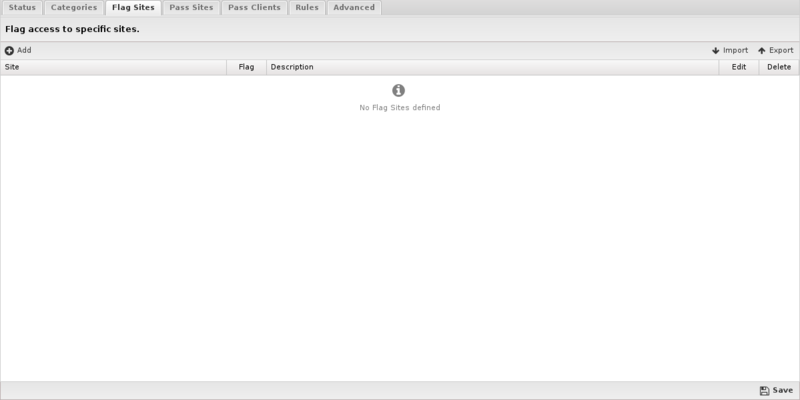
Pass Sites
Pass Sites is used to pass content that would have otherwise been flagged. This can be useful for "unflagging" sites that you don't want flagged according to flag settings. Any domains you add to the Passed Sites list will be allowed, even if flagged by category or by individual URL - just add the domain and save. Unchecking the pass option will allow the site to be flagged as if the entry was not present. This list uses URL Matcher syntax.

Pass Clients
If you add an IP address to this list, Web Monitor will not flag any traffic from that IP regardless of the flagged categories or sites. Just add the IP and save. Unchecking the pass option will have the flag/pass lists affect the user as if they were not entered into the Passed Client IPs list. This list uses IP Matcher syntax.
- If you have a few users that need to completely bypass Web Monitor controls, consider using pass lists. If you have users that simply need different Web Monitor settings, you should set up a separate rack using Policy Manager. When using this feature, please remember that DHCP IPs can change, so you'll probably want to set up either a Static IP or a Static DHCP Lease for the machine in question.
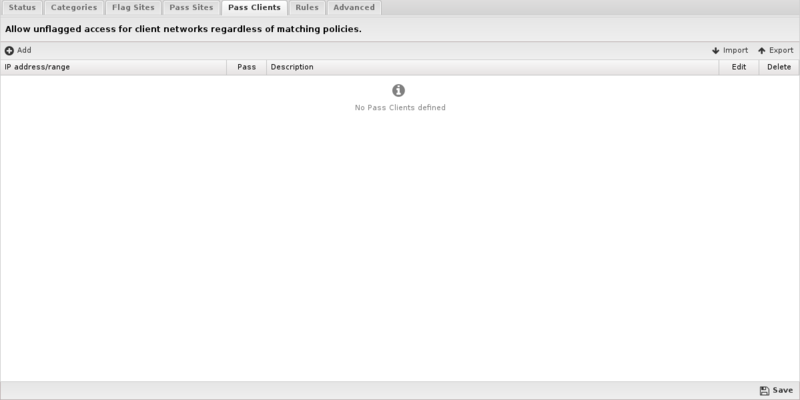
Rules
The Rules tab allows you to specify rules to Flag traffic that passes through Web Monitor.
The Rules documentation describes how rules work and how they are configured. Web Monitor uses rules to determine when to flag specific sessions. Flagging a session marks it in the logs for reviewing in the event logs or reports, but has no direct effect on the network traffic.
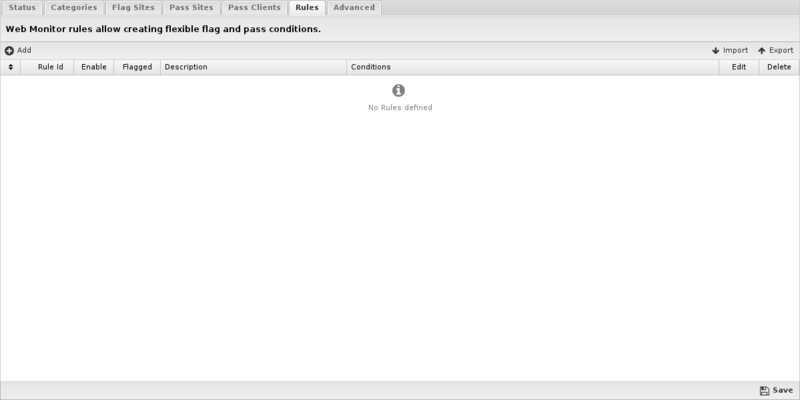
Rule Actions
- Flag: Allows the traffic which matched the rule to flow, and flags the traffic for easier viewing in the event log.
Rule Types
In previous versions of Web Monitor, there were dedicated lists for flagging certain file extensions or MIME types. This capability is still available using the more flexible filter rules. For flagging specific file extensions, you can create a rule with the condition Web Filter: Response File Extension that has a comma separated list of the extensions to flag in the Value field. For flagging MIME types, you would create a rule with the condition Web Filter: Response Content Type that has a comma separated list of the content types to flag in the Value field.
Below are tables that list the default file extensions and MIME types that were available in previous versions. Note that these lists are not exhaustive, but are included here as a reference, and to simplify creation of such rules via copy/paste of the values in the tables.
| Extension | Category | Description |
|---|---|---|
| exe | executable | an executable file format |
| ocx | executable | an executable file format |
| dll | executable | an executable file format |
| cab | executable | an ActiveX executable file format |
| bin | executable | an executable file format |
| com | executable | an executable file format |
| jpg | image | an image file format |
| png | image | an image file format |
| gif | image | an image file format |
| jar | java | a Java file format |
| class | java | a Java file format |
| swf | flash | the flash file format |
| mp3 | audio | an audio file format |
| wav | audio | an audio file format |
| wmf | audio | an audio file format |
| mpg | video | a video file format |
| mov | video | a video file format |
| avi | video | a video file format |
| hqx | archive | an archived file format |
| cpt | compression | a compressed file format |
| Content | Category | Description |
|---|---|---|
| application/octet-stream | unspecified data | byte stream |
| application/x-msdownload | Microsoft download | executable |
| application/exe | executable | executable |
| application/x-exe | executable | executable |
| application/dos-exe | DOS executable | executable |
| application/x-winexe | Windows executable | executable |
| application/msdos-windows | MS-DOS executable | executable |
| application/x-msdos-program | MS-DOS program | executable |
| application/x-oleobject | Microsoft OLE Object | executable |
| application/x-java-applet | Java Applet | executable |
| audio/mpegurl | MPEG audio URLs | audio |
| audio/x-mpegurl | MPEG audio URLs | audio |
| audio/mp3 | MP3 audio | audio |
| audio/x-mp3 | MP3 audio | audio |
| audio/mpeg | MPEG audio | audio |
| audio/mpg | MPEG audio | audio |
| audio/x-mpeg | MPEG audio | audio |
| audio/x-mpg | MPEG audio | audio |
| application/x-ogg | Ogg Vorbis | audio |
| audio/m4a | MPEG 4 audio | audio |
| audio/mp2 | MP2 audio | audio |
| audio/mp1 | MP1 audio | audio |
| application/ogg | Ogg Vorbis | audio |
| audio/wav | Microsoft WAV | audio |
| audio/x-wav | Microsoft WAV | audio |
| audio/x-pn-wav | Microsoft WAV | audio |
| audio/aac | Advanced Audio Coding | audio |
| audio/midi | MIDI audio | audio |
| audio/mpeg | MPEG audio | audio |
| audio/aiff | AIFF audio | audio |
| audio/x-aiff | AIFF audio | audio |
| audio/x-pn-aiff | AIFF audio | audio |
| audio/x-pn-windows-acm | Windows ACM | audio |
| audio/x-pn-windows-pcm | Windows PCM | audio |
| audio/basic | 8-bit u-law PCM | audio |
| audio/x-pn-au | Sun audio | audio |
| audio/3gpp | 3GPP | audio |
| audio/3gpp-encrypted | encrypted 3GPP | audio |
| audio/scpls | streaming mp3 playlists | audio |
| audio/x-scpls | streaming mp3 playlists | audio |
| application/smil | SMIL | audio |
| application/sdp | Streaming Download Project | audio |
| application/x-sdp | Streaming Download Project | audio |
| audio/amr | AMR codec | audio |
| audio/amr-encrypted | AMR encrypted codec | audio |
| audio/amr-wb | AMR-WB codec | audio |
| audio/amr-wb-encrypted | AMR-WB encrypted codec | audio |
| audio/x-rn-3gpp-amr | 3GPP codec | audio |
| audio/x-rn-3gpp-amr-encrypted | 3GPP-AMR encrypted codec | audio |
| audio/x-rn-3gpp-amr-wb | 3gpp-AMR-WB codec | audio |
| audio/x-rn-3gpp-amr-wb-encrypted | 3gpp-AMR_WB encrypted codec | audio |
| application/streamingmedia | Streaming Media | audio |
| video/mpeg | MPEG video | video |
| audio/x-ms-wma | Windows Media | video |
| video/quicktime | QuickTime | video |
| video/x-ms-asf | Microsoft ASF | video |
| video/x-msvideo | Microsoft AVI | video |
| video/x-sgi-mov | SGI movie | video |
| video/3gpp | 3GPP video | video |
| video/3gpp-encrypted | 3GPP encrypted video | video |
| video/3gpp2 | 3GPP2 video | video |
| audio/x-realaudio | RealAudio | audio |
| text/vnd.rn-realtext | RealText | text |
| audio/vnd.rn-realaudio | RealAudio | audio |
| audio/x-pn-realaudio | RealAudio plug-in | audio |
| image/vnd.rn-realpix | RealPix | image |
| application/vnd.rn-realmedia | RealMedia | video |
| application/vnd.rn-realmedia-vbr | RealMedia VBR | video |
| application/vnd.rn-realmedia-secure | secure RealMedia | video |
| application/vnd.rn-realaudio-secure | secure RealAudio | audio |
| audio/x-realaudio-secure | secure RealAudio | audio |
| video/vnd.rn-realvideo-secure | secure RealVideo | video |
| video/vnd.rn-realvideo | RealVideo | video |
| application/vnd.rn-realsystem-rmj | RealSystem media | video |
| application/vnd.rn-realsystem-rmx | RealSystem secure media | video |
| audio/rn-mpeg | MPEG audio | audio |
| application/x-shockwave-flash | Macromedia Shockwave | multimedia |
| application/x-director | Macromedia Shockwave | multimedia |
| application/x-authorware-bin | Macromedia Authorware binary | multimedia |
| application/x-authorware-map | Macromedia Authorware shocked file | multimedia |
| application/x-authorware-seg | Macromedia Authorware shocked packet | multimedia |
| application/futuresplash | Macromedia FutureSplash | multimedia |
| application/zip | ZIP | archive |
| application/x-lzh | LZH archive | archive |
| image/gif | Graphics Interchange Format | image |
| image/png | Portable Network Graphics | image |
| image/jpeg | JPEG | image |
| image/bmp | Microsoft BMP | image |
| image/tiff | Tagged Image File Format | image |
| image/x-freehand | Macromedia Freehand | image |
| image/x-cmu-raster | CMU Raster | image |
| image/x-rgb | RGB image | image |
| text/css | cascading style sheet | text |
| text/html | HTML | text |
| text/plain | plain text | text |
| text/richtext | rich text | text |
| text/tab-separated-values | tab separated values | text |
| text/xml | XML | text |
| text/xsl | XSL | text |
| text/x-sgml | SGML | text |
| text/x-vcard | vCard | text |
| application/mac-binhex40 | Macintosh BinHex | archive |
| application/x-stuffit | Macintosh Stuffit archive | archive |
| application/macwriteii | MacWrite Document | document |
| application/applefile | Macintosh File | archive |
| application/mac-compactpro | Macintosh Compact Pro | archive |
| application/x-bzip2 | block compressed | compressed |
| application/x-shar | shell archive | archive |
| application/x-gtar | gzipped tar archive | archive |
| application/x-gzip | gzip compressed | compressed |
| application/x-tar | 4.3BSD tar archive | archive |
| application/x-ustar | POSIX tar archive | archive |
| application/x-cpio | old cpio archive | archive |
| application/x-bcpio | POSIX cpio archive | archive |
| application/x-sv4crc | System V cpio with CRC | archive |
| application/x-compress | UNIX compressed | compressed |
| application/x-sv4cpio | System V cpio | archive |
| application/x-sh | UNIX shell script | executable |
| application/x-csh | UNIX csh script | executable |
| application/x-tcl | Tcl script | executable |
| application/x-javascript | JavaScript | executable |
| application/x-excel | Microsoft Excel | document |
| application/mspowerpoint | Microsoft Powerpoint | document |
| application/msword | Microsoft Word | document |
| application/wordperfect5.1 | Word Perfect | document |
| application/rtf | Rich Text Format | document |
| application/pdf | Adobe Acrobat | document |
| application/postscript | Postscript | document |
Advanced
The Advanced section allows you to configure additional Web Monitor options.
- Process HTTPS traffic by SNI (Server Name Indication) if present: If this option is enabled, HTTPS traffic will be categorized using the "Server Name Indication" in the HTTPS data stream, if present. More details in #HTTPS Options.
- Process HTTPS traffic by hostname in server certificate when SNI information not present: If this option is enabled and SNI information is not present, the certificate is fetched from the HTTPS server and the server name on the certificate will be used for categorization and filtering purposes.
- Process HTTPS traffic by server IP if both SNI and certificate hostname information are not available: If this option is enabled and neither of the previous options worked, HTTPS traffic will be categorized using the IP address. More details in #HTTPS Options.
- Clear Category URL Cache: This option will clear the local cache of categorized sites and URLs. After clearing the cache all new web visits will be looked up fresh using the categorization service. The cache automatically cleans itself as entries become old or stale, so this is mostly for testing.
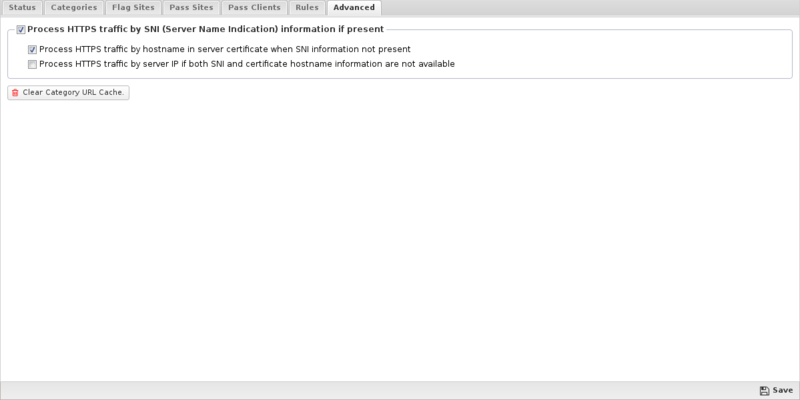
Reports
The Reports tab provides a view of all reports and events for all traffic handled by Web Monitor.
Reports
This applications reports can be accessed via the Reports tab at the top or the Reports tab within the settings. All pre-defined reports will be listed along with any custom reports that have been created.
Reports can be searched and further defined using the time selectors and the Conditions window at the bottom of the page. The data used in the report can be obtained on the Current Data window on the right.
Pre-defined report queries: {{#section:All_Reports|'Web Monitor'}}
The tables queried to render these reports:
HTTPS Options
There are many ways to handle HTTPS. An overview of the various techniques is described here.
If SSL Inspector is installed and inspects a session, then it is fully decrypted to HTTP before Web Monitor processes the session. In this case HTTPS is treated identically to HTTP. If SSL Inspector is not installed or the session is not inspected, there are still several techniques to handle encrypted HTTP sessions.
There are three HTTPS options.
- Process HTTPS traffic by SNI (Server Name Indication) if present.
- Process HTTPS traffic by hostname in server certificate when SNI information not present
- Process HTTPS traffic by server IP if both SNI and certificate hostname information are not available.
If Process HTTPS traffic by SNI (Server Name Indication) if present encrypted port-443 traffic will be scanned. Most modern browsers on modern OSs will send the hostname of the server in cleartext - this is called "Server Name Indication" or SNI. SNI is an optional cleartext field in the HTTPS request that shows the hostname of the server. If this option is enabled and the SNI information is present in the HTTPS request, this hostname will be used as the URL for this request and all categorization, flag lists, and pass lists, will be processed as if this were a regular HTTP request to that URL.
If the SNI-based categorization determines the page should be passed (and/or flagged) then the session is allowed and the appropriate event based on the SNI information is logged ("https://example.com/").
For example, if the user visits "https://wellsfargo.com/welcome" in the browser, it will see "wellsfargo.com" as the SNI information. If enabled, the request will be handled exactly like "http://wellsfargo.com" would be. If "Banking" is flagged it will be flagged, unless "wellsfargo.com" is in the pass list or the client IP is in the client IP pass list. If "wellsfargo.com" is flaggeed it will be flagged, unless "wellsfargo.com" is in the pass list or the client IP is in the client IP pass list.
If No SNI information is present and Process HTTPS traffic by hostname in server certificate when SNI information not present is enabled, then the hostname will be pulled from the certificate presented to the client.
For example, if the user visits "https://wellsfargo.com/welcome" in a non-SNI enabled browser, then there is no SNI information. In this case if Process HTTPS traffic by hostname in server certificate when SNI information not present is enabled it will use the certificate information instead to categorize the session. It will download the certificate from the site and see that the certificate is "Issued To" "www.wellsfargo.com." It will use this information to check the category for "https://www.wellsfargo.com" and categorize the session.
If no SNI or certificate information was available and Process HTTPS traffic by server IP if both SNI and certificate hostname information are not available the session will be processed and categorized by IP address. If the IP-based processing and categorization of the web requests determines the session should be flagged, the session is reset and no more processing of this session will be done. If the IP-based processing and categorization determines the page should be passed (and/or flagged) then the session is allowed and the appropriate event based on its IP is logged ("https://1.2.3.4").
For example, if the user visits "https://wellsfargo.com/welcome" in a non-SNI enabled browser, then there is no SNI information. If the the certificate information was missing for some reason then this session can only be identified by IP address. In this case if Process HTTPS traffic by server IP if both SNI and certificate hostname information are not available is enabled it will use the IP address instead. So it will process/categorize this web request as 'http://1.2.3.4' if 1.2.3.4 is the IP of wellsfargo.com. This will still often result in correct categorization for dedicated web servers, but does poorly when using generic cloud computing servers that offer a wide variety of websites.
Note: Neither HTTPS process (SNI, certificate, or IP-based categorization) can read the URI information as it is not sent in cleartext. As such the URI will not be used as part of the categorization and the URI is assumed to be "/" when evaluating pass rules. If scanning the URI is necessary then full SSL Inspection may be required. Read here for more information
To see the HTTPS categorization in action use the "All HTTPS Events" query in the event log.
Web Monitor FAQs
Why is there a pass list if Web Monitor can't block sites?
Web Monitor is useful for monitoring web activity, and as part of that it is often useful to flag certain web activity to make it more visible in reports. Adding a site to the pass list will prevent the site from being flagged even if it otherwise would be because the category is flagged or a rule flags it.
Can I block sites with Web Monitor?
No. Web Monitor is for monitoring web activity only. In order to modify or block web content Web Filter is required.
